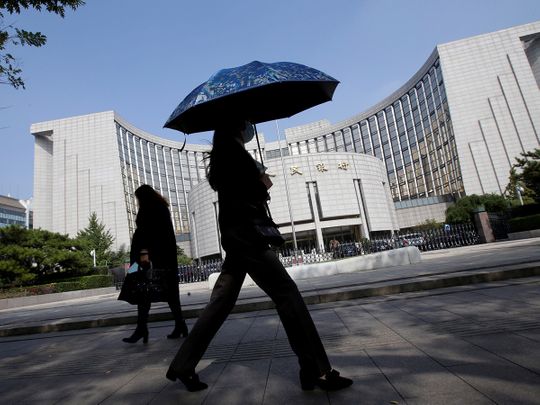
BEIJING: China’s central bank said on Friday it was cutting the amount of cash that banks have to hold as reserves for the fifth time in a year, freeing up $116 billion for new lending as it tries to reduce the risk of a sharp economic slowdown.
The cut comes amid mounting worries about the health of the world’s second-largest economy, which is facing both slowing demand at home and punishing US tariffs on its exports.
Global stock markets sold off on Thursday after a warning from tech giant Apple Inc about slowing China sales, while data this week showed manufacturing activity shrank in December for the first time in more than two years.
The announcement came just hours after Premier Li Keqiang said China would take further action to bolster the economy, including reserve requirement ratio (RRR) cuts and more cuts in taxes and fees, highlighting the urgency to cope with increasing headwinds.
“This speedy RRR cut with great intensity fully demonstrates the determination of policymakers to stabilise growth,” said Yang Hao, an analyst at Nanjing Securities.
“At present, the economy is facing very big downward pressure amid internal and external troubles.” The cut in RRR is the first in 2019 by the People’s Bank of China (PBOC). It cut the ratio for all banks, freeing up a net 800 billion yuan ($116.51 billion) after lenders use some of the 1.5 trillion yuan in liquidity released to pay back maturing medium-term loans.
The size of the cut was at the upper end of market expectations, and the net funds released would be the largest amount in the five cuts since last January.
“Policy easing will be stepped up further over coming months,” Capital Economics said in a research note.
“With credit growth still slowing and, typically, a six-month lag before any turnaround in credit affects the economy, worries about the outlook for China will persist for several months yet.” RRRs — currently 14.5 per cent for large institutions and 12.5 per cent for smaller banks — will be lowered by a total of 100 basis points in two stages, the PBOC said.
The cuts will be effective January 15 and January 25, ahead of the long Lunar New Year celebrations when cash conditions often get tight.
More help coming
Further cuts in the RRR had been widely expected this year, especially after a spate of weak data in recent months showed the economy was continuing to lose steam amid increased signs of a pinch from the trade war with the United States.
China reported on Monday that factory activity shrank in December for the first time in over two years.
China and the United States will hold vice ministerial level trade talks in Beijing on January 7-8, as they seek to end a dispute that is inflicting increasing pain on both economies and roiling global financial markets.
But the central bank said growth was still within a reasonable range and it would continue to implement a prudent monetary policy, without engaging in massive stimulus.
“We will maintain reasonable and sufficient liquidity, maintain reasonable growth in the scale of money and credit and social financing, stabilise macro-leverage and seek internal and external balances,” it said.
Analysts say Beijing will have to keep up a steady stream of stimulus to engineer a sustainable economic turnaround. But they note policy transmission difficulties faced by the central bank to boost credit for private and small firms — which are vital for economic growth and jobs.
Cutting benchmark interest rates may be a last resort as that could weigh on the yuan and fuel debt risks, analysts say.
The central bank said on Friday, after a work meeting, that it would keep liquidity reasonably ample, and market interest rates steady.
Economists believe the government could take more fiscal steps by cutting taxes and boosting spending on infrastructure, amid expectations that the budget deficit ratio could be lifted to 3 per cent in 2019 from 2.6 per cent last year.
Still, economic growth is thought to have cooled to around 6.5 per cent last year — which would be the weakest since 1990 — in line with the target but down from 6.9 per cent in 2017.
A further deceleration is seen this year, with some analysts forecasting growth will cool to just over 6 per cent.












